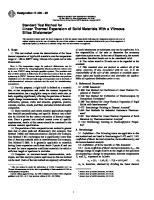Measurement of The Thermal Conductivity of Composite Solid Materials [PDF]
Modal Analysis of Functionally-Graded Metal-Ceramic Composite Plates E. Gutierrez-Miravete 1 , W. L. Saunders II2 , K. P
41 0 129KB
Papiere empfehlen
![Measurement of The Thermal Conductivity of Composite Solid Materials [PDF]](https://vdoc.tips/img/200x200/measurement-of-the-thermal-conductivity-of-composite-solid-materials.jpg)
- Author / Uploaded
- Kamel Fedaoui
Datei wird geladen, bitte warten...
Zitiervorschau
Modal Analysis of Functionally-Graded Metal-Ceramic Composite Plates E. Gutierrez-Miravete 1 , W. L. Saunders II2 , K. Pendley 3 1 Rensselaer at Hartford,
Hartford, CT, USA Dynamics Electric Boat, Groton, CT, USA 3 United Technologies - Pratt & Whitney, East Hartford, CT, USA 2 General
Abstract Introduction Isotropic metal-matrix composites (MMCs) enhance the strength achievable with metal alloys alone though the reinforcing effect of dispersed hard particulates in a continuous metal matrix. Functionally-graded isotropic MMCs expand the range of possibilities through detailed spatial control of the concentration of particulates. This variation can be readily produced in practice using any of the various additive manufacturing processes now available (e.g. spray deposition). The determination of the modes of vibration of FG-MMC plates is important in practice in order to prevent undesired resonances in structural components. This paper describes the application of COMSOL Multiphysics® software for the determination of the modes of vibration of Aluminum A356-T6Alloy-ZrO2 MMC FG square plates. Use of COMSOL Multiphysics A commonly used expression to describe the variation in the volume fraction of ZrO2, cZrO2 through a flat plate of thickness H is V = (1/2 + z/H)p where p is the parameter describing the rate of change of concentration with distance. The local density can then be estimated using the rule of mixtures but using the Mori-Tanaka formulation must be used to obtain the necessary values of the Elastic modulus and Poisson's ratio at any point in the FG material from the available values of the pure components. Although relatively straightforward, the resulting expressions are cumbersome but all the necessary formulae are readily entered in the global parameters. The solid mechanics eigenfrequency study in COMSOL was used to create a model of a square plate (1 m x 1 m x 0.05 m). The plate was constrained along its lower edges to prevent motion normal to its plane. The model was meshed using the default mesh and the modes of vibration were calculated.
Results As an example of the results obtained, figure 1 shows the computed fourth vibration mode of a plate with p=10 and Figure 2 shows a summary of computed results for various cases. Additional details about the model and results for other systems can be found in Mr. Saunders Rensselaer Master's Project report. Conclusion The frequencies of vibration of FG-MMC plates were calculated. The necessary position dependent property values were calculated using the Mori-Tanaka method and entered in equation form in the COMSOL simulation. The resulting frequencies were found to be in very good agreement with those calculated using a recently developed closed-form approximation and also with those calculated using another FEA program.
Reference 1. G. Dvorak, Micromechanics of Composite Materials, Springer, NY, 2013, pp. 184-188. 2. E. Efraim, Procedia Engineering, 10 (2011) 242-247. 3. W. L. Saunders, Modal Analysis of Rectangular Simply Supported Functionally Graded Plates, Mechanical Engineering Master’s Project Report, Rensselaer at Hartford, 2011. 4. K. Pendley, Modal Analysis of Simply Supported Functionally Graded Square Plates, Mechanical Engineering Master’s Project Report, Rensselaer at Hartford, 2014.
Figures used in the abstract
Figure 1: Fourth vibration mode of FG-MMC plate with p=10.
Figure 2: Vibration frequencies for three different composite plates and the pure components.









